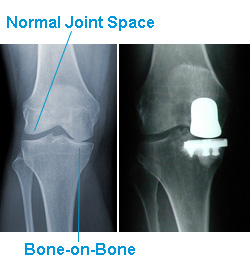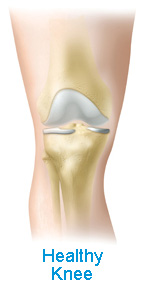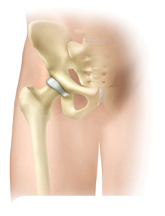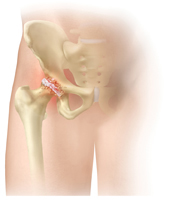Robotic-Assisted Knee or Hip Surgery
Call 435.893.6362ROSA robotic assistant for knee and hip replacement surgery
 ROSA, which stands for robotic surgical assistant, is a new technology used for total knee and total hip joint replacements. The orthopedic surgeons at Castleview Hospital have been specially trained to use this technology. ROSA assists the surgeons in tailoring the placement of an implant. Not only does robotic-assisted surgery personalize the approach to total knee and hip replacements, but it also optimizes a patient's recovery with better implant positioning, which can result in a more natural-feeling knee and hip after surgery.
ROSA, which stands for robotic surgical assistant, is a new technology used for total knee and total hip joint replacements. The orthopedic surgeons at Castleview Hospital have been specially trained to use this technology. ROSA assists the surgeons in tailoring the placement of an implant. Not only does robotic-assisted surgery personalize the approach to total knee and hip replacements, but it also optimizes a patient's recovery with better implant positioning, which can result in a more natural-feeling knee and hip after surgery.
If you or a loved one have been experiencing knee or hip pain, the below information may be useful in helping you understand an overview of knee and hip pain and the treatment options available. Speaking with an orthopedic surgeon will allow you to know if robotic-assisted surgery is the right fit for your specific needs.
Next Steps
Knee Pain Overview and Treatment Options
Knee Pain
The knee is the largest joint in the body. A healthy knee moves easily, allowing you to walk, turn, and do many other activities without pain.
Every day, your knees must support your full body weight. Cartilage is the “shock absorber” of your knee joints, but over a lifetime it can start to wear away. This "wear and tear" arthritis (osteoarthritis) is the most common cause of knee pain.
Without your cartilage protecting your knees, your bones grind against each other, which causes you pain: pain that you can feel climbing stairs, working in the garden, or just trying to sit down. It may even keep you up at night.

The knee is a type of hinge joint formed by the tibia (shinbone), femur (thighbone), and patella (kneecap). The ends of the bones in the knee joint are covered with cartilage, a tough, lubricating tissue that helps provide smooth, pain-free motion to the joint.
Osteoarthritis, the most common form of arthritis, is a wear and tear condition that destroys joint cartilage, and it typically develops after years of constant motion and pressure in the joints. As the cartilage continues to wear away, bone begins to rub against bone, causing the irritation, swelling, stiffness, and discomfort commonly associated with arthritis.



Knee Treatment Options
Conservative Treatment Options
There are a number of non-surgical, or conservative, treatment options for osteoarthritis and other forms of arthritis. Typically, non-surgical options start with gentle exercise and physical therapy. As the arthritis becomes more painful and limiting, the non-surgical treatment options become more involved.
Surgery, including joint replacement, is generally only recommended after all other conservative treatment options fail to provide relief. Always talk to your primary care physician or to your orthopedic surgeon before starting any treatment plan. Your doctors will help you develop a plan that will best fit your specific condition.
Arthroscopy
Arthroscopy uses tiny instruments inserted into the joint through small punctures. Damaged tissue can be removed or repaired within the joint providing relief from both pain and swelling while possibly preventing further damage to the knee.
Rebuilding Cartilage
In some patients, a pothole occurs in the joint cartilage on the end of the bone. Various methods may be used to try to correct this problem. The following methods are used primarily for young patients with moderate or isolated cartilage injury.
Microfracture Arthroplasty
Microfracture arthroplasty uses an arthroscope to drill small holes into the exposed bone. The holes are designed to encourage cartilage to grow. This procedure is reserved for small areas of damage.
Direct Cartilage Transplantation
Direct cartilage transportation takes healthy cartilage and moves it to a damaged area of cartilage. This procedure is reserved for younger patients with small defects, not for patients with significant arthritis.
Growing Cartilage
Cartilage cells can be harvested during an arthroscopic procedure and then grown in a lab for later transplantation. These cells are then implanted into the defect. Again, this procedure is reserved for younger patients with small defects, not for patients with significant arthritis.
Partial Knee Replacement
The knee is composed of three separate compartments. Osteoarthritis sometimes develops in only one compartment of the knee, while the other two compartments remain relatively healthy. Patients who have osteoarthritis in only one compartment may be candidates for partial knee replacement.
The advantage of a partial knee is that it resurfaces only the damaged cartilage of the knee, preserving the undamaged cartilage. The benefits of this procedure include a smaller incision (3,4 inches), a quicker recovery, and less bone removal. The disadvantages are that partial knee surgery may not last as long as total joint replacement surgery. You and your surgeon will determine if a partial knee is appropriate for you.
Minimally Invasive Surgery: Reducing Trauma to Your Knee
Biomet was the first company to introduce a minimally invasive surgical technique for total knee replacement. Our Microplasty® Minimally Invasive Instrumentation reduces the incision from 6-8" to 3-4". Additionally, this approach reduces the extent to which the surgeon must disrupt the soft tissue surrounding the knee. As a result, your muscles, ligaments, and tendons will undergo less trauma during surgery. This may help reduce post-operative pain, improve your recovery time, and get you back on your feet faster.
Potential Benefits of the Rapid Recovery Program are:
- Shorter hospital stays
- Earlier mobilization
- Accelerated recovery process
- Less blood loss
- Reduction of scar tissue
Total Knee Replacement
Your surgeon may recommend knee replacement surgery if you have significant arthritis. Surgeons don't actually replace the joint as is commonly thought. Your surgeon actually replaces the damaged cartilage found at the ends of the bones in your knee joint. Perhaps it should be called "cartilage replacement surgery."
Knee replacement implants to resurface the joint are typically made from metal alloy and polyethylene (plastic). The implants are designed to restore function and eliminate as much discomfort as possible while allowing you to return to a more active lifestyle.
Rehabilitation and walking begin the day after surgery, and the hospital stay is normally 3 to 4 days. Therapy will begin in the hospital and usually continues after discharge for approximately 6 to 12 weeks.
Knee Replacement surgery has been extremely successful in helping patients with arthritis return to their normal activities and relieve their discomfort.
Hip Pain
Your hip is one of the largest weight-bearing joints in your body. When it's working properly, it lets you walk, sit, bend, and turn without pain. To keep it moving smoothly, a complex network of bones, cartilage, muscles, ligaments, and tendons must all work in harmony. Over time, wear and tear can result in worn cartilage and broken or deteriorated bone. This wear and tear is called osteoarthritis and it is the most common cause of hip pain.
The hip is a ball-and-socket joint that allows the leg to move in a variety of positions. The femoral head (ball) rides in the acetabulum (socket). The joint is lined with a lubricating tissue called cartilage, which cushions the joint as it moves and bears weight.
Osteoarthritis, the most common form of arthritis, is a wear and tear condition that destroys joint cartilage, and it typically develops after years of constant motion and pressure in the joints. As the cartilage continues to wear away, bone begins to rub against bone, causing the irritation, swelling, stiffness, and discomfort commonly associated with arthritis.

Healthy Hip

Hip Arthritis
Hip Treatment Options
Conservative Treatment Options
There are a number of non-surgical, or conservative, treatment options for osteoarthritis and other forms of arthritis. Typically, non-surgical options start with gentle exercise and physical therapy. As the arthritis becomes more painful and limiting, the non-surgical treatment options become more involved.
Surgery, including joint replacement, is generally only recommended after all other conservative treatment options fail to provide relief. Always talk to your primary care physician or to your orthopedic surgeon before starting any treatment plan. Your doctors will help you develop a plan that will best fit your specific condition.
The ASI Technique: Reducing Trauma to Your Hip
Minimally invasive hip replacement involves more than just a shorter incision. Modern minimally invasive techniques also focus on the way surgeons gain access to the hip joint. The goal is to minimize muscle and tendon disruption, making surgery less traumatic for patients, allowing for shorter hospital stays and quicker recoveries.

Anterior Supine Intermuscular (ASI) Hip Replacement
Unlike traditional minimally invasive hip replacement techniques, the ASI technique uses an incision at the front of the hip instead of the side or back of the hip. This modified incision placement allows surgeons to directly approach the hip joint by going between the muscles that surround the hip joint. Traditional approaches would require cutting the muscles and/or tendons that surround the hip. The ASI minimally invasive hip replacement procedure is designed to reduce the trauma to the tissues surrounding the hip joint. By preserving the muscles and tendons, surgeons may enable their patients to walk the day of surgery, to experience less postoperative pain, and to return to daily activities more quickly.1
How is the Biomet® ASI Technique Unique?
Biomet worked with leading surgeons to develop unique instrumentation to make the ASI approach reproducible for other surgeons. Similar techniques require a special, costly operating fracture table. The ASI technique can be performed on either this special fracture table or on a traditional operating room table. Hundreds of thousands of people undergo total hip replacement every year in the United States. Many patients are not candidates for other minimally invasive hip surgery techniques due to obesity or other considerations. The ASI technique has the advantage of potentially offering a minimally invasive option for patients who would not otherwise be considered for other minimally invasive approaches.
Potential Benefits of the ASI Technique are:1
- Shorter hospital stays
- Earlier mobilization
- Accelerated recovery process
- Less blood loss
Total Hip Replacement
When non-operative treatment fails to control the discomfort and stiffness from arthritis of the hip, your surgeon may recommend total hip replacement. Joint replacement implants, typically made from metal alloy and polyethylene (plastic), are used to resurface the joint. Newer implants with metal sockets are now being used in selective patients. Total hip replacement replaces the upper end of the femur (thighbone) and resurfaces the acetabulum (socket). The implants are designed to restore function and eliminate as much discomfort as possible while allowing you to return to a more active lifestyle.
Rehabilitation and walking begin the day after surgery, and your hospital stay is normally 3 to 4 days. Therapy will begin in the hospital and usually continues after discharge for approximately six to twelve weeks.
Joint replacement surgery of the hip has been extremely successful in helping patients with arthritis return to their normal activities and relieve their discomfort.
Home Preparation for Joint Replacement Surgery
When you and your orthopedic surgeon decide that joint replacement surgery is the best option to relieve pain and restore motion, you will begin the normal preparation for surgery. You should notify your surgeon about any of the medications you are presently taking because some medications must be stopped before surgery. All surgeries carry certain risks and possible complications. Before surgery, your orthopedic surgeon will explain the possible complications. Your orthopedic surgeon may ask you to see your primary care physician to make sure that you do not have any health conditions that may complicate your surgery.
You may be asked to donate blood before your surgery. There are several options regarding blood donation and surgery, and all of these options should be explained to you. Surgery also requires anesthesia.
There may be some options regarding anesthesia and they will be explained to you. Your options will be based on your health history, the medications you presently take, and the results of your physical examination.
Your surgeon may also recommend that you start a strengthening program before surgery. The prescribed exercises are designed to help add strength, flexibility. Strengthening your muscles before surgery can assist your postoperative recovery.
After hip replacement or other joint replacement surgery, your orthopedic surgeon will give you a specific recovery plan that you should carefully follow. Do not attempt exercises that are not prescribed by your surgeon, and do not attempt to alter your recovery schedule. It takes time for your joint to heal properly.
Planning ahead for your return home.
- Launder all of your dirty clothing before your surgery. Have loose, comfortable clothing set aside for your recovery time.
- Prepare single-serving meals before your surgery. These meals can be heated quickly in a microwave and there is less to clean up.
- Be sure to remove loose rugs and other trip hazards such as electrical cords and magazine racks from walking paths to avoid accidents or falls. If necessary, widen furniture paths to accommodate a walker or cane.
- To simplify accessibility, place regularly used items such as remote controls, medications, and reading materials in easy-to-reach locations.
- Un-tuck bedding to allow for easier access in and out of your bed. If your bedroom is on a second floor, it may be helpful to temporarily relocate your sleeping arrangements to a single floor. This will avoid having to climb stairs when you are not feeling your best.
- Having some assistance after total joint replacement can also be very beneficial. Contact family members or friends ahead of time so they may make the necessary arrangements to assist in your recovery.
